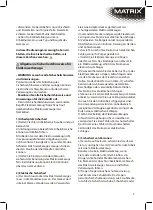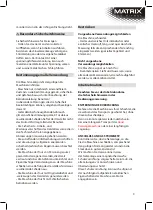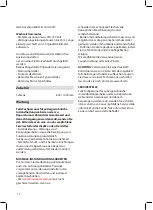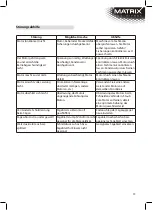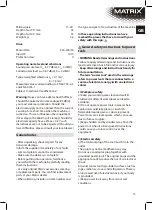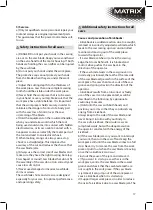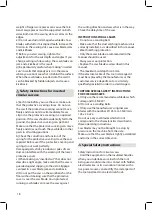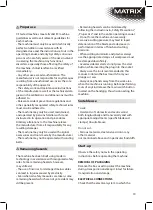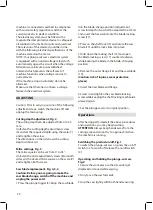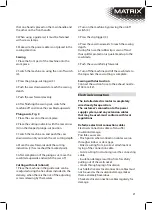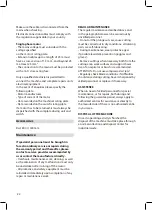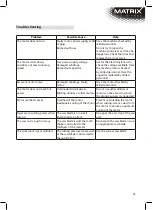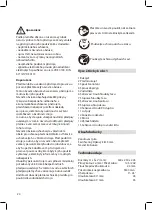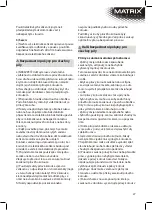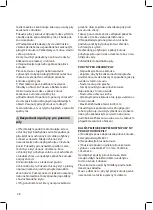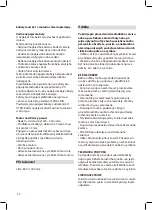
17
5) Service
a) Only let qualified service personnel repair your
tool and always use original replacement parts.
This guarantees that the power tool remains safe
to use.
Safety instructions for all saws
a) DANGER: Do not put your hands in the sawing
area or on the saw blade. Keep your second hand
on the extra handle of the motor housing. If both
hands are holding the saw, neither can be injured
by the saw blade.
b) Do not put your hands under the work piece.
The protective cap cannot protect your hands
from the blade when they are under the work
piece.
c) Adjust the cutting depth to the thickness of
the work piece. Less than one complete sawing
tooth should be visible under the work piece.
d) Never hold the work piece that is to be sawn
in your hand or over your leg. Make sure that the
work piece has a stable balance. It is important
that the work piece is held securely, in order to
minimize the danger of contact of a body part
with the saw, loss of control over the saw,
or jamming of the blade.
e) Hold the equipment on the insulated handles,
when you undertake work in which the tool
being used could come into contact with hidden
electrical wires, or its own cable. Contact with a
live power source can electrify the metal parts of
the tool and lead to an electrical shock.
f) When making a long cut, always use a stop
chock or a straightedge. This improves the
accuracy of the cut and reduces the chance that
the saw blade jams.
g) Always use the correct size of saw blades and
make sure they have the right locating bore (e.g.
Star shaped or round). Saw blades that do not fit
the assembly of the saw do not run correctly and
cause loss of control.
h) Never use damaged or incorrect saw blade
shims or screws.
The saw blade shims and screws are designed
especially for your saw, for optimal performance
and operating safety.
Additional safety instructions for all
saws
Causes and prevention of kickbacks:
• A kickback is a sudden reaction due to a caught,
jammed or incorrectly adjusted saw blade, which
leads to the saw rearing up in an uncontrolled
manner and moving out of the work piece
towards the operator.
• If a saw blade catches or jams in the sawing
edge that closes behind it, it is blocked and
motor’s drive pushes the saw back in the
direction of the operator.
• If the saw blade twists in the saw groove or is
incorrectly positioned, the teeth at the rear side
of the saw blade edge catch in the surface of the
work piece. The saw then moves out of the saw
groove and springs back in the direction of the
operator.
• A kickback results from an incorrect or faulty
use of the saw. It can be prevented, as will be
described in the following, by appropriate
cautionary measures.
a) Hold onto the saw with both hands and
position your arms so that they can absorb any
energy from a kickback.
Always keep to the side of the saw blade, and
never bring it into line with your body. In
the case of a kickback, the circular saw can
jump backwards, but with adequate caution
the operator can deal with the energy of the
kickback.
b) If the saw blade jams or you want to interrupt
your work, then turn the saw off and keep the
work piece still until the saw blade comes to a full
stop. Never try to remove the saw from the work
piece or pull it out when the saw blade is moving
since then a kickback can occur.
Find out the cause of the jam and remove it.
c) If you want to start up a saw that is in the
work piece, centre the saw blade in the sawed
groove and check that the saw blade teeth are
not caught in the work piece. If the saw blade
is jammed, it can jump out of the work piece or
cause a kick back when it is started up.
d) Support larger work pieces in order to reduce
the risk of a kick back due to a saw blade jam. The
Summary of Contents for PS 1000-45
Page 2: ...2...



